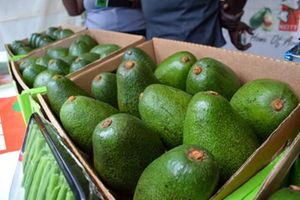
A farmer packs his Hass avocados in a farm in Nakuru.
I am a regular reader of Seeds of Gold magazine and wish to start avocado farming soon. Kindly advise on how to produce quality and quantity avocado.- James Ndirangu
Thank you James for your interest in avocado farming. The following are the practices that will ensure you get quality and quantity avocado fruits.
The site for planting avocados should be free from anthills, level or gentle sloped and well-sheltered from strong winds.
Land should be properly ploughed and harrowed to remove perennial weeds.
It is also advisable to grow maize or sunflower a year before planting the avocados.
The square planting pattern is usually used. A spacing of 10m x 10m or 10m x 8m (rectangular) gives plant populations of 100 and 125 trees per hectare, respectively. Planting holes are of size 45cm x 45cm x 45cm.
Holes are filled with top soil, mixed with about 30 kilogrammes of manure and 125g of DSP fertiliser.
The seedlings are delivered in polythene bags and carefully removed to cause little disturbance to the roots.
They are ordinarily planted at a higher level than they were in the nursery to allow for settling.
After planting, they are watered and mulched. The best time to plant is when the long rains are just starting.
Normally, no pruning is required besides the removal of broken and diseased branches; and trimming those touching the ground.
Sucker growth is checked to remove shoots coming out of the rootstock.
The farmer needs to ensure the orchard is weed-free.
It is recommended to have vegetables growing between the rows of young plantations. Beans have shown great results.
Nothing should be planted closer than two metres from the tree.
Higher crops such as maize and sunflower should not be inter-cropped with avocados.
In order to have a good yield of avocados, irrigation is necessary, especially in the dry period.
The quantity of water applied depends on the moisture characteristics of the soil and age of the trees.
It, however, varies from 25 to 35 litres per tree every fortnight.
Since avocados do not tolerate salinity, the water used should be free from salts.
In order to obtain maximum growth and optimum harvests, it is important to supply the avocado with necessary nutrients.
It is, however, dangerous to give excessive amounts on any size of trees at one time as that could cause root damage, leaf burn and defoliation.
The type of fertiliser to be used depends on soil pH.
In the planting year, it is advisable not to top dress the orchard since this may retard root development during the first four to five months after planting.
After this period, 60g of 26 per cent Nitrogen fertilise should be applied after every three months when the soil is moist.
In addition, about 25 kilogrammes of well-rotten manure should be spread around the trees after every year.
Farmyard manure is strongly recommended because it improves the physical condition of the soil and promotes the absorption in the soil and uptake by the plant of micro-nutrients.
Avocado trees also have a very high requirement for potassium, magnesium and zinc.
Measures should, therefore, be taken to supplement these nutrients when they fall short.
Nematodes attack roots and cause growth stunting. These are controlled by fumigating the soil before planting.
Fruit flies attack the ripening fruit. To control this pest, spray the plants with malathion or fenthion.
Thrips normally raid young leaves and are controlled by spraying with Rogor40 or any other synthetic insecticide.
Other avocado pests are mites, scales and aphids.
Sunblotch (virus) shows very slight symptoms of yellow to brown areas on young branches, leaf petioles and leaves.
In severe cases, there can be die-back of branches, reduction of growth, grooves on stems and branches.
Fruits develop sunken areas and later become brown. Control is by use of virus-free budwoods.
Cut down infected trees and destroy them to prevent the spread of the deadly disease.
Phytophthora root rot (Phytophthora cinnamoni) is a root rot disease which is common under wet conditions.
Spray the avocado trees with copper fungicides (copper oxychloride) and always use resistant rootstocks.
Armillaria root rot (Armillaria spp) is another disease. Roots rot and the tree may be killed under severe infection. Spray with copper fungicides.
The first yields can be expected in the third year after planting.
Avocado fruits do not soften on the trees when mature and, therefore, it is not easy to determine the time of harvest by external appearance.
Read:
The fruits do not mature at the same time.
Maturity is determined by harvesting some fruits, which are assumed to be mature and stored at room temperature.
If they soften within a maximum period of 12 days without shrivelling, they are considered ready for picking.
Other indications of maturity are:
The loss of a glossy sheen normally observed in immature fruits, when there is a yellowish tint to the skin and stem, when the green fruit becomes smoother, especially at the end opposite the stem and small corky areas appear on the skin.
Lastly, when the seed is examined in the ripe fruit the seed coat appears dark brown and its tissue is very thin.
During harvesting, the fruit must be clipped with secateurs from the trees; a stalk of about a centimetre should be left on the fruit.
Never pull the fruits because this encourages rotting.
It is recommended that cotton gloves be used during picking, grading and packing to avoid bruising.
Fruits should never be dropped. They should be placed gently in baskets or boxes during picking. Fruits should be delivered to the grading and packing station as soon as possible.







